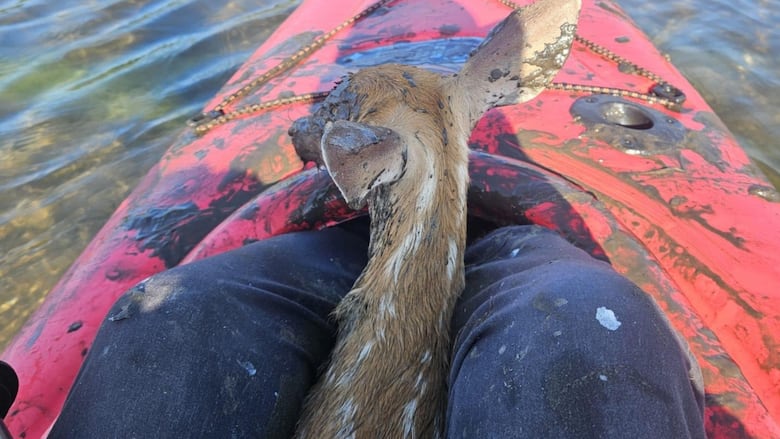Oh deer! Fawns rescued from precarious situations in 2 N.S. communities
Residents provide helping hand to animals trapped in Sherose Island, Truro

Talent Wilson was walking her dog on Friday morning on Sherose Island near Barrington Passage, N.S., when she noticed an unusual sight — a crying fawn stuck in the marsh by her home.
With the tide beginning to roll in where the little fawn was mired in mud, Wilson recognized the danger that might be involved in trying to rescue it and flagged down a passing municipal truck for assistance.
"I'm waving him down and I just go out and I'm like, 'There's a deer stuck. What are we gonna do? Can you do anything?'" said Wilson.
As luck would have it, Darren Brown, the Municipality of Barrington employee whose help she enlisted, had a kayak on hand and quickly made his way in the rising water to the fawn. He tucked the distressed animal between his legs inside the kayak and paddled it back to the safety of solid ground.
In a different set of circumstances more than 300 kilometres away, Alton Rushton discovered a fawn trapped in a gated culvert on Saturday morning in Truro.
"The small deer was able to fall down between there and it was trapped down inside probably about six to eight feet down below," said Rushton.
He initially tried to climb down himself but then sought out assistance from two other people. While the crying fawn kept retreating further into the culvert, a Truro police officer eventually joined in the effort.
"I stepped aside and the police officer had some gloves on. So, he figured it's better to handle it with gloves. And [another rescuer] passed it out to him and we put them up on the other side of the train tracks," said Rushton.

Hope Swinimer from the Hope for Wildlife animal rehabilitation centre in Seaforth, N.S., said it's normal to see fawns without their mothers at this time of year. Does tuck their fawns in areas they deem safe and only come back to feed them in the morning and at dusk, she said.
But the fawn is also liable to wander from that spot.
"That's all quite normal. But mom calls that baby in and she has a way to communicate and the baby will recognize the mom's call, and the babies call the mom also. But usually the mom isn't as far away as you think," said Swinimer.
She said there are ways to determine if a fawn is in need of assistance.
"If there's flies buzzing around or they're laying with their feet out to their side or they've been crying for more than an hour or two hours, that's an indicator there might be something wrong. And that's when we get involved and we go and check to see how they are."
Wilson is just relieved she found the despairing fawn on Sherose Island before something happened.
"You don't want to see any animals suffer like that," she said.
Brown joked that he hopes the fawn and its mother have reunited so the fawn can relay a message he delivered just before getting it back on dry land from the kayak.
"I told him, 'You tell your mother what I done and you tell your mother to stay out of my garden,'" he said with a chuckle.